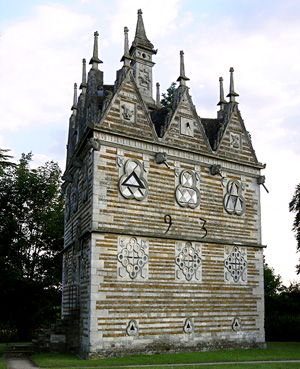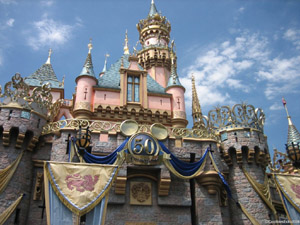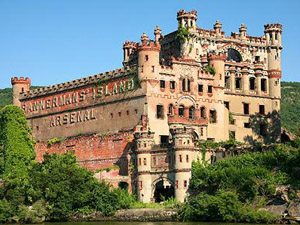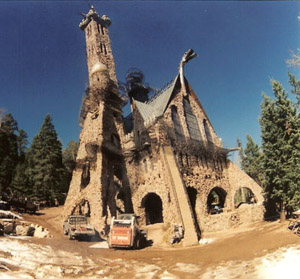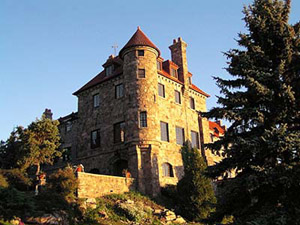Types of Castle and The History of CastlesRomantic & Decorative Castles |
|
|
||||||||||||||||||||||||||||||||||||||||||||||||||||||||
Romantic & Decorative Castles
As Europe, or at least parts of it, became more stable great magnates started to build great houses for pleasure rather than defence. In England for example the reigns of Henry VIII and Elizabeth I saw many ministers of the crown building great country houses such as Burley. But the lure of traditional castles is strong. Many builders preferred to keep to the traditional appearance and built romantic imitation castles. You can generally spot them immediately as they have large windows on the first and second floors. (Real castles never had windows below the third floor, and often not below the top floor, and sometimes no external windows at all.) But the rule does not always hold, since some real medieval castles had windows fitted retrospectively. Below are some categories of romantic and decorative European castle:
|
|
|||||||||||||||||||||||||||||||||||||||||||||||||||||||
|
||||||||||||||||||||||||||||||||||||||||||||||||||||||||
Loire Valley Châteaux
Loire Valley châteaux include castle fortifications from the 10th century, but the most famous of them are the renaissance châteaux, of which there are more than 300. When English and French kings began constructing huge châteaux here, the nobility, wanting as always to be near the seat of power, followed them in building castles here. Their presence in the lush, fertile valley began attracting the fashionable landscape designers. The Loire Valley (in French: La Vallée de la Loire) is known as the Garden of France and the Cradle of the French Language. It is also noted for its architectural heritage, in its historic towns as well as its castles. Particularly famous are the spectacular Château d'Amboise, Château de Chambord, Château d'Ussé, Château de Villandry and Chenonceau which illustrate Renaissance architectural ideals in the age of the Enlightenment. By the middle of the 16th century, King Francois I of France had shifted the centre of power in France from the Loire back to Paris. With him went the great architects, but the Loire Valley continued to be the place where French royalty preferred to spend most of their time. With the ascension to the throne of Louis XIV in the middle of the 17th century, Paris was established as the permanent site for great royal châteaux like Versailles. Even so, those who sought the king's favour continued to renovate existing châteaux or build lavish new ones as summer residences in the Loire Valley. In 2000, UNESCO added the central part of the Loire River valley, between Maine and Sully-sur-Loire, to its list of World Heritage Sites. The UNESCO committee said that the Loire Valley is: "an exceptional cultural landscape, of great beauty, comprised of historic cities and villages, great architectural monuments - the Châteaux - and lands that have been cultivated and shaped by centuries of interaction between local populations and their physical environment, in particular the Loire itself." The French Revolution saw a number of the great French châteaux destroyed and or ransacked, many of their treasures being stolen during this period. The impoverishment of the surviving deposed nobility, saw many châteaux sold off or demolished. During World War I and again during World War II, châteaux were commandeered as military headquarters. Some of these continued to be used this way even after the end of the Second World War. Today, many of these privately-owned châteaux serve as homes. Some open their doors to tourists. Others are operated as hotels or rent self catering apartments, or offer bed and breakfasts. Yet others have been taken over by local government authorities. Great Royal Chateaux like those at Chambord are owned and operated by the national government and are major tourist sites, attracting hundreds of thousands of visitors each year. |
|
|||||||||||||||||||||||||||||||||||||||||||||||||||||||
|
|
||||||||||||||||||||||||||||||||||||||||||||||||||||||||
Castles of Ludwig II of Bavaria
Ludwig Friedrich Wilhelm; Ludwig II of Bavaria, was king of Bavaria from 1864 until shortly before his death in 1886. He is sometimes locally referred to as Unser Kini, which means "our darling king" in Bavarian. der Märchenkönig (the Fairy tale King) in High German and as the Swan King in English. Ludwig is sometimes also referred to as "Mad King Ludwig". He was certainly eccentric, but there is some doubt as to whether he was really mad (Ludwig was deposed on grounds of mental illness without any medical examination, and died a day later under mysterious circumstances) King Ludwig is still revered by many in Bavaria today as his legacy of grandiose castle building realises massive tourist revenue. He commissioned the construction of several extravagant fantasy castles and was a devoted patron of the composer Richard Wagner. Ludwig avoided formal social events whenever possible, and preferred a life of fantasy that he pursued with various creative projects. These idiosyncrasies caused tension with the king's government ministers, but not with common Bavarians. The king enjoyed traveling in the Bavarian countryside and chatting with farmers and labourers he met along the way. He also delighted in rewarding those who were hospitable to him during his travels with lavish gifts. Ludwig used his personal fortune to fund the construction of a series of elaborate castles. In 1861 he visited Viollet-le-Duc's work at Pierrefonds, in France, which influenced the style of their construction. In 1868, Ludwig commissioned the first drawings for two of his buildings. The first was Schloss Neuschwanstein, or "New Swanstone Castle", a dramatic Romanesque fortress with soaring fairy-tale towers. The second was Herrenchiemsee, a replica of the central section of the palace at Versailles, France, Herrenchiemsee which was to be sited on the Herren Island in the middle of the Chiemsee Lake, was meant to outdo its predecessor in scale and opulence. The following year, he finished the construction of the royal apartment in the Residenz Palace in Munich, which was followed three years later by the addition of an opulent conservatory or Winter Garden on the palace roof. It featured an ornamental lake with gardens and painted frescoes, and was roofed over using a technically advanced metal and glass construction. In 1869, Ludwig oversaw the laying of the cornerstone for Schloss Neuschwanstein on a breathtaking mountaintop site overlooking his childhood home, the castle his father had built at Hohenschwangau. The walls of Neuschwanstein are decorated with frescoes depicting scenes from many of Wagner's operas. In 1872, he began construction for a special festival theatre dedicated to the works of Richard Wagner, in the town of Bayreuth. A few years later, he watched early versions of Wagner’s Ring Cycle operas there, though he avoided the public performances. In 1878, construction was completed on Ludwig’s Schloss Linderhof, an ornate palace in neo-French Rococo style, with handsome formal gardens. The grounds contained a Venus grotto lit by electricity, where opera singers performed while Ludwig was rowed in a boat shaped like a shell. In the grounds a romantic woodsman's hut was also built around an artificial tree. The hut, referred to as Hundings Hut, is a reference to a similar structure in der Ring des Niebelungen. There is a sword embedded in the tree. In Walküre, Siegfried's father Siegmund, pulls the sword from the tree. Also in 1878, construction began on his Versailles-derived Herrenchiemsee. In the 1880s, Ludwig’s plans proceeded undimmed. He planned construction of a new castle on the Falkenstein near Pfronten in the Allgäu (based on the tower of St Mary's Church, Baldock), a Byzantine palace in the Graswangtal and a Chinese summer palace in Tyrol. By 1885, demolition for the beginning of the Falkenstein project was underway, and the road to the site had been graded. On 13 June 1886 Luwig's castle building career came to an abrupt end. Around6 pm, Ludwig asked a friend to accompany him on a walk along the shore of Lake Starnberg. The friend agreed, and told the guards not to follow them. The two men never returned. At 11:30 that night, searchers found both the king and his friend dead, floating in the shallow water near the shore. |
|
|||||||||||||||||||||||||||||||||||||||||||||||||||||||
|
||||||||||||||||||||||||||||||||||||||||||||||||||||||||
Neo-Gothic Castles
Gothic architecture belonged to the Medieval period, but examples date from later periods. In 1663 a Gothic hammerbeam roof was built at the Archbishop of Canterbury's London residence, Lambeth Palace. It replaced one destroyed during the English Civil War. Also in the late 17th century, Gothic details appeared on new construction at Oxford and Cambridge, notably on Tom Tower at Christ Church, Oxford, by Christopher Wren. It is not obvious whether these instances were Gothic survival or early appearances of Gothic revival. In England in the mid-18th century, the Gothic style was more widely revived, first as a decorative, whimsical alternative to Rococo that is still conventionally termed 'Gothick', of which Horace Walpole's Twickenham villa "Strawberry Hill" is the most famous example. A preference for neo Gothic architecture affected church buildings even more than secular buildings. In England, partly in response to a philosophy propounded by the Oxford Movement and others associated with the emerging revival of 'high church' or Anglo-Catholic ideas during the second quarter of the nineteenth century, neo-Gothic began to become promoted by influential establishment figures as the preferred style for ecclesiastical, civic and institutional architecture. The appeal of this Gothic revival gradually widened to encompass "low church" as well as "high church" clients. This period of more universal appeal, spanning 1855-1885, is known in Britain as High Victorian Gothic. The Houses of Parliament in London by Sir Charles Barry with interiors by a major exponent of the early Gothic Revival, Augustus Welby Pugin, is an example of the Gothic revival style from its earlier period in the second quarter of the 19th century. Built to designs. Examples from the High Victorian Gothic period include Sir George Gilbert Scott's design for the Albert Memorial in London, and William Butterfield's chapel at Keble College, Oxford. From the second half of the nineteenth century onwards it became more common in Britain for neo-Gothic to be used in the design of non-ecclesiastical and non-governmental buildings types. Gothic details even began to appear in working-class housing schemes subsidised by philanthropy, though due to the expense, less frequently than in the design of upper and middle-class housing. In France, simultaneously, the towering figure of the Gothic Revival was Eugène Viollet-le-Duc, who outdid historical Gothic constructions to create a Gothic as it ought to have been, notably at the fortified city of Carcassonne in the south of France and in some richly fortified keeps for industrial magnates. Viollet-le-Duc compiled and coordinated an Encyclopédie médiévale that was a rich repertory his contemporaries mined for architectural details. He effected vigorous restoration of crumbling detail of French cathedrals, including the Abbey of Saint-Denis and famously at Notre Dame, where many of whose most "Gothic" gargoyles are Viollet-le-Duc's. He taught a generation of reform-Gothic designers and showed how to apply Gothic style to modern structural materials. In Germany, the great cathedrals of Cologne and Ulm, left unfinished for 600 years, were brought to completion, while in Italy, Florence Cathedral finally received its polychrome Gothic façade. New churches in the Gothic style were created all over the world, including Mexico, Argentina, Japan, Thailand, India, Australia, New Zealand, Hawaii and South Africa. As in Europe, the United States, Canada, Australia and New Zealand utilised Neo-Gothic for the building of universities, a fine example being Sydney University by Edmund Blacket. In Canada, the Canadian Parliament Buildings in Ottawa designed by Thomas Fuller and Chilion Jones with its huge centrally placed tower draws influence from Flemish Gothic buildings. Although falling out of favour for domestic and civic use, Gothic for churches and universities continued into the 20th century with buildings such as Liverpool Cathedral, the Cathedral of Saint John the Divine, New York and São Paulo Cathedral, Brazil. The Gothic style was also applied to iron-framed city skyscapers such as Cass Gilbert's Woolworth Building and Raymond Hood's Tribune Tower. Post-Modernism in the late 20th and early 21st centuries has seen some revival of Gothic forms in individual buildings, such as the Gare do Oriente in Lisbon, Portugal and a finishing of the Cathedral of Our Lady of Guadalupe in Mexico. |
|
|||||||||||||||||||||||||||||||||||||||||||||||||||||||
|
|
||||||||||||||||||||||||||||||||||||||||||||||||||||||||
Scots Baronial Castles
Scots Baronial castles are not castles belong to Scottish barons, but imitation castles built in the "Scots Baronial" style. The Scots Baronial style is part of the Gothic revival in architectural styles, drawing on stylistic elements and forms from castles, tower houses and mansions of the Renaissance period in Scotland, such as Craigievar Castle and Newark Castle, Port Glasgow. The revival style was popular from the early 19th century until World War I. One of the earliest examples of Scottish Baronial style was Abbotsford House, the residence the famous novelist and poet, Sir Walter Scott, built for himself on the Tweed River in the Scottish Border Country. Buildings of the style frequently feature towers adorned by small turrets. Roof lines are uneven, their crenulated battlements often broken by stepped gables. While small lancet windows may appear in towers and gables, large bay windows of plate glass were not uncommon, but even these would often have their individual roofs adorned by pinnacles and crenellations. Porches, porticos and porte-cocheres, were often given the full castle treatment, an imitation portcullis on the larger houses would occasionally be suspended above a front door, flanked by heraldic beasts and other medieval architectural motifs. This architectural style was also employed for public buildings, such as Aberdeen Grammar School. It was by no means confined to Scotland and is a fusion of the Gothic revival castle architecture first employed by Horace Walpole for his Twickenham villa, Strawberry Hill, and the ancient Scottish defensive tower houses. In the 19th century it became fashionable for private houses to be built with small turrets and dubbed in Scottish Baronial style. In fact the architecture often had little in common with tower houses, which retained their defensive functions and fell short of 19th century ideas of comfort. Balmoral Castle shows the final Victorian embodiment of the style. A principal keep similar to Craigievar is the heart of the castle, while a large turreted country house is attached In Ireland a young English architect of the York School of Architecture, George Fowler Jones, designed Castle Oliver, a 110 room mansion of approx 29,000 sq ft (2,700 m2), built in a similar pink sandstone to Belfast Castle. Castle Oliver had all the classic hallmarks of the style, including battlements, porte-cochere, crow-stepped gables, numerous turrets, arrow slits, spiral stone staircases, and conical 'witch's hat' roofs. In New Zealand it was advocated by the architect Robert Lawson who designed frequently in this style most notably at Larnach Castle in Dunedin. Other examples in New Zealand include works by Francis Petre. In Toronto Casa Loma was built on a hilltop site, 1911 – 14, for Sir Henry Pellatt, a prominent financier and industrialist. His architect, E. J. Lennox, provided him with battlements and towers, tempered by modern plumbing and other conveniences. Another Canadian example is the Banff Springs Hotel in the Banff National Park in Alberta, Canada. This hotel is still very much in use. The style was popular in Scotland and was applied to many relatively modest dwellings by architects such as Edward Calvert. Several real Scottish castles were rebuilt in the Scottish Baronial style. During the 19th century it became fashionable for the aristocracy to leave London to visit Scotland during the month of August for the shooting, and many aristocrats favoured this style for the shooting and sporting estates they created at this time in Scotland, often building "castles" of immense proportions such as Skibo Castle and Balmoral Castle. The 20th-century Scottish Baronial castles have had the reputation of architectural follies. Among most patrons and architects the style fell from favour along with the Gothic revival in the early years of the 20th century. |
|
|||||||||||||||||||||||||||||||||||||||||||||||||||||||
|
||||||||||||||||||||||||||||||||||||||||||||||||||||||||
Follies
A folly is a building constructed primarily for decoration, but either suggesting by its appearance some other purpose, or so extravagant that it transcends the normal range of garden ornaments or other class of building to which it belongs. In the original use of the word, these buildings had no other use, but from the 19-20th centuries the term was also applied to highly decorative buildings which had secondary practical functions. In the 18th century English gardens and French landscape gardening often featured Roman temples, which symbolized classical virtues or ideals. Other 18th century garden follies represented Chinese temples, Egyptian pyramids, ruined abbeys, or Tatar tents, to represent different continents or historical eras. Sometimes they represented rustic villages, mills and cottages, to symbolize rural virtues.
Follies began as decorative accents on the great estates of the late 16th and early 17th centuries but they flourished especially in the two centuries which followed. Many estates had ruins of monastic houses and (in Italy) Roman villas; others, lacking such buildings, constructed their own sham versions of these romantic structures. Apart from their decorative aspect, many follies originally had a use which was lost later, such as hunting towers. Follies (French: fabriques) were an important feature of the English garden and French landscape garden in the 18th century, such as Stowe and Stourhead in England and Ermenonville and the gardens of Versailles in France. They were usually in the form of Roman temples, ruined Gothic abbeys, or Egyptian pyramids. Painshill Park in Surrey contained almost a full set, with a large Gothic tower and various other Gothic buildings, a Roman temple, a hermit's retreat with resident hermit, a Turkish tent, a shell-encrusted water grotto, among other features. In France they sometimes took the form of romantic farmhouses, mills and cottages, as in Marie Antoinette's Hameau de la Reine at Versailles. Sometimes they were copied from landscape paintings by painters such as Claude Lorrain and Hubert Robert. Often they had symbolic importance, illustrating the virtues of ancient Rome, or the virtues of country life. The temple of philosophy at Ermenonville, left unfinished, symbolized that knowledge would never be complete, while the temple of modern virtues at Stowe was deliberately ruined, to show the decay of contemporary morals. Later in the 18th century, the follies became more exotic, representing other parts of the world- they included Chinese pagodas, Japanese bridges, and Tatar tents. The Irish Potato Famine of 1845-49 led to the building of several follies. Society held that reward without labour was misguided. However, to hire the needy for work on useful projects would deprive existing workers of their jobs. The obvious solution was, construction projects termed "famine follies". These include: roads in the middle of nowhere, between two seemingly random points; screen and estate walls; piers in the middle of bogs, and so on. |
|
|||||||||||||||||||||||||||||||||||||||||||||||||||||||
|
|
||||||||||||||||||||||||||||||||||||||||||||||||||||||||
Castles in the USAMost castles in the United States cannot properly be described as real castles. They are primarily country houses, follies, or other buildings designed to give the appearance of a castle to people who know little about castles. They are often designed in one of the following styles: Gothic Revival, Châteauesque, Romanesque Revival, Scots Baronial or Tudor Revival. Here is a list in alphabetical order:
Bancroft Tower, Worcester, Massachusetts, a small-scale castle built in 1900 in memory of George Bancroft. It is listed on the U.S. National Register of Historic Places. Bannerman's Castle, also known as Bannerman's Island Arsenal, Hudson River, Cornwall-on-Hudson, New York, built 1901–18. The structure was built as a military surplus warehouse in the style of a Romanesque castle by businessman Francis Bannerman. An explosion in 1920 destroyed a portion of the complex. The empty and partially collapsed shell remains as a picturesque ruin. It is listed on the U.S. National Register of Historic Places. Beacon Towers, Sands Point, New York on the North Shore of Long Island, built 1917–18 for Alva Vanderbilt Belmont It featured a combination of the Châteauesque and a unique Gothic style. It was demolished in 1945. Beardslee Castle, Little Falls, New York, built in 1860. It is an eclectic Gothic Revival style house with a rusticated stone facade. Belcourt Castle, Newport, Rhode Island, a Châteauesque mansion built 1891–94 for Oliver Belmont. Belvedere Castle, Vista Rock, Central Park, New York City, built as a folly in 1869. It was designed by Calvert Vaux and Frederick Law Olmsted, after they were reappointed to oversee the park's construction in 1865. The stone structure is a hybrid of the Gothic and Romanesque styles. Berkeley Castle, Bath, West Virginia, built for Colonel Samuel Taylor Suit in 1885. It is listed on the U.S. National Register of Historic Places. Bettendorf Castle, also known as Vianden Castle, Fox River Grove, Illinois, built in 1931–32. Biltmore Estate, Asheville, North Carolina, 175,000-square-foot (16,300 m2) Châteauesque style mansion built 1889–95 for George Washington Vanderbilt. It is the largest privately held home in the United States. It is a U.S. National Historic Landmark. Bishop Castle, Wet Mountains, Rye, Colorado. Construction began on this eccentric structure in 1969 and was still in progress in 2010. Built by one man, Jim Bishop, the building facade is rubble stone, with a 160-foot (49 m) tower and a variety of self-made iron ornaments and bridges. Boldt Castle, Heart Island, Thousand Islands, New York, main house built from 1900 to 1904. Grounds also include additional castle-like follies. Boston University Castle or BU Castle, Boston, Massachusetts, built from 1904 to 1915. It is a Tudor Revival style mansion owned by Boston University. Bowman's Castle, Fayette County, Pennsylvania, built in 1789, it is the oldest Gothic Revival castle in the United States. It is listed on the U.S. National Register of Historic Places. Bull Run Castle, Aldie, Virginia, hand-built from 1980 to 1999 by the owner, John Roswell Miller, and his family. It is two stories with four round corner towers, a large central round tower at the rear, and a crenelated roof-line. Campbell Castle, Wichita, Kansas, built in 1888 for Burton Harvey Campbell in the Baronial style. Canterbury Castle, also known as Arlington Castle, Portland, Oregon, built 1929–1931. Designed by Jeter O. Frye. The 6,000-square-foot (560 m2), three-story house featured a moat, drawbridge, and towers. It was demolished in 2009. It was formerly listed on the U.S. National Register of Historic Places. Carey Mansion, originally known as Seaview Terrace, Newport, Rhode Island, built 1923–28 in the Châteauesque style. Used for the exterior shots in the Dark Shadows gothic soap opera. Carrollcliffe, now Castle Hotel and Spa, Tarrytown, NY, built in two phases from 1897-1910 for General Howard Carroll. Castello di Amorosa, Calistoga, California, built 1995–2007. It is a working winery. Castle at Castle Park, near Holland, Michigan, built in 1890 for Michael Schwarz. It now serves as a community center for the Castle Park Association. Castle at Casa Basso, Westhampton, New York, built in 1906 by artist Theophilus Brower. The small castle with Moorish arches has been adjoined by a restaurant, Casa Basso, since 1928. Castle Craig, Hubbard Park, Meriden, Connecticut, 32 feet (9.8 m) high tower built in 1900. Castle Gatehouse, a pumping station for the Washington Aqueduct in Washington, D.C., built 1899–1901. It is listed as a contributing building on the U.S. National Register of Historic Places. Castle Gwynn, Triune, Tennessee, built 1980–present for Mike Freeman. The current plan calls for four towers with a keep, but so far only the first two towers have been completed. Freeman partially modeled the castle on Castell Coch in Tongwynlais, Wales. Castle Museum, Saginaw, Michigan, designed by William Martin Aikenbuilt and built in 1897. It is listed on the U.S. National Register of Historic Places. Castle of Heron Bay, Lake Worth, Texas Formerly known as Whiting Castle, and commonly known as The Lake Worth Castle. Originally a three room farm house built circa 1860, the property was won in a poker game by Samuel E. Whiting, who expanded and embellished the structure in the style of a castle, during the 1920s. Castle Post, Lexington, Kentucky, built from 1969 to 2008. Castle Rock, Garrison, New York, built in 1881 for Illinois Central Railroad president William H. Osborn. It is listed on as a historic district on the U.S. National Register of Historic Places. Castle San Miguel, Hanceville, Alabama Chateau Laroche, also known as Loveland Castle, Loveland, Ohio, built 1929. Chateau Rochamore, Stamford, Connecticut, built from 1903 to 1906. Designed by the owner-architect, Gustav E. Steinback, the stone and half-timbered house has Norman and other medieval architectural influences. Cherokee Castle, formerly Charlford Castle, Sedalia, Colorado, built from 1924 to 1926 by Charles Alfred Johnson. Cinderella Castle, Walt Disney World, Lake Buena Vista, Florida, a children's folly built 1971 as a theme park attraction. Coe Hall, Oyster Bay, New York, built for William Robertson Coe on his Planting Fields estate from 1915 to 1919. The three-story Tudor Revival mansion features a primary facade with a combination of carved stone, dressed stone, and some exposed half-timbering that gives it the look of having been built at different periods in history. It was designed by Walker & Gillette. The grounds were designed by Guy Lowell, with later work by the Olmsted Brothers firm. It is listed on the U.S. National Register of Historic Places. Coindre Hall, Huntington, New York, 80,000-square-foot (7,400 m2) Châteauesque style mansion built for George McKesson Brown from 1910 to 1912. It is listed on the U.S. National Register of Historic Places. Copenhaver Castle, Camelback Mountain, Phoenix, Arizona, completed in 1977 by Mort Copenhaver. Coral Castle, Homestead, Florida, limestone megalithic structure built by Edward Leedskalnin from 1920 to 1948. It is listed on as a historic district on the U.S. National Register of Historic Places. Curwood Castle, Owosso, Michigan, Châteauesque style mansion built for James Oliver Curwood from 1922 to 1923. It is listed on the U.S. National Register of Historic Places. Druim Moir Castle, Philadelphia Pennsylvania, built from 1885 to 1886 for Pennsylvania railroad tycoon Henry H. Houston. It is listed on as a historic district on the U.S. National Register of Historic Places. Dunham Castle, Wayne, Illinois, Châteauesque style house built for Mark Wentworth Dunham in 1880. It is listed on as a historic district on the U.S. National Register of Historic Places. Dunmere, Narragansett, Rhode Island, built in 1883 for Robert Graham Dun. The stone mansion features towers and cupolas. It is listed on the U.S. National Register of Historic Places. Eastern State Penitentiary, Philadelphia, Pennsylvania, built in 1829 as the first prison to utilize the separate system of prison management. It is a U.S. National Historic Landmark. Edward Everett Estate, Bennington, Vermont, built as a summer home from 1911 to 1914 at an estimated cost of $2 million for Edward Everett of the American Bottle Company. Fair Lane, Dearborn, Michigan, built from 1909 to 1913 for Ford Motor Company founder Henry Ford. Architects who worked on the design of the estate included Frank Lloyd Wright, Marion Mahony Griffin, and Joseph Nathaniel French. French was responsible for the final Baronial style of the main house. It is a U.S. National Historic Landmark. Fonthill, Doylestown, Pennsylvania, built 1908–12 for Henry Chapman Mercer. It is listed as a contributing building on the U.S. National Register of Historic Places. Franklin Castle, also known as the Hannes Tiedemann House, Cleveland, Ohio, built in 1881 for Hannes Tiedemann. It is listed on the U.S. National Register of Historic Places. Gillette Castle, Hadlyme, Connecticut, built in 1914 for William Gillette. It is listed on the U.S. National Register of Historic Places. Glamorgan, Alliance, Ohio, built from 1904 to 1905 for William Henry Morgan. The exterior features a facade of Vermont marble. It is listed on the U.S. National Register of Historic Places. Glencairn, Bryn Athyn, Pennsylvania, built in a unique Romanesque style from 1928 to 1939. It was designed by the owner, Raymond Pitcairn, for his family. It has more than 100 rooms and a seven story tower. It is now a museum. It is listed as a contributing building on the U.S. National Register of Historic Places. Glen Eyrie, Colorado Springs, Colorado, Tudor Revival style house built in 1871 for William Jackson Palmer. It is listed on the U.S. National Register of Historic Places. Grey Court, also known as Tenney Castle, Methuen, Massachusetts, built from 1890 to 1892 for Charles H. Tenney. The Châteauesque style mansion was designed by Carrère and Hastings, with influences primarily derived from the Château d'Yquem. It was destroyed by arson in 1978. Grey Towers Castle, Arcadia University, Glenside, Pennsylvania, built 1881–83 for William Welsh Harrison. It was designed by Horace Trumbauer. |
|
|||||||||||||||||||||||||||||||||||||||||||||||||||||||
|
Hammond Castle, Gloucester, Massachusetts, built from 1926 to 1929 for John Hays Hammond, Jr. It is a U.S. National Historic Landmark. Harbor Hill, Roslyn, New York, on the North Shore of Long Island overlooking Hempstead Harbor, built 1899–1902 for Clarence Mackay. The house alone cost $781,483. It was designed by McKim, Mead & White in the Châteauesque style, with heavy influences from the Château de Maisons. The grounds were designed by Guy Lowell. The main house was demolished in 1947. Hartlands, Old Saybrook, Connecticut, completed in 1908 for George Watson Beach. Designed by Alfredo S.G. Taylor, it combines Tudor Revival and Gothic Revival with some other early 20th century influences. The 15,000-square-foot (1,400 m2) stone mansion features a three-story crenelated tower. It is listed on the U.S. National Register of Historic Places. Hazard Castle, adjacent to Rhode Island Sound, Narragansett, Rhode Island, built in 1882 for Joseph Peace Hazard. The stone Gothic Revival mansion includes a 105-foot (32 m) tall crenelated tower. It is listed as a contributing building on the U.S. National Register of Historic Places. Hearst Castle, San Simeon, California, built from 1919 to 1947 for William Randolph Hearst. The main house was designed by Julia Morgan in a unique mixture of Mediterranean Revival, Renaissance and Baroque styles. It is a U.S. National Historic Landmark. Hearthstone Castle, Danbury, Connecticut, built in a Norman style from 1895 to 1899 for E. Starr Sanford. It is listed on the U.S. National Register of Historic Places. Hempstead House, Sands Point, New York, on the North Shore of Long Island, built from 1909 to 1912 for Howard Gould. It contains two stone Tudor Revival style structures with towers. Hempstead House is the main house. Castle Gould contained the stables and the servants quarters. It is listed on as a historic district on the U.S. National Register of Historic Places. Henderson Castle, Kalamazoo, Michigan, built in the Queen Anne style with an exterior facade of Lake Superior sandstone and brick in 1895. Herreshoff Castle, Marblehead, Massachusetts, completed in 1927. Hippol Castle, also known as Gimghoul Castle, Chapel Hill, North Carolina, built 1924 as the meeting place for a collegiate secret society called the Order of Gimghoul. Joslyn Castle, also known as Lynhurst, Omaha, Nebraska, built in the Baronial style in 1903. It was built from Kansas limestone and cost approximately $250,000 to build. It is listed on the U.S. National Register of Historic Places. Kimberly Crest, Redlands, California, completed in 1896 for Cornelia A. Hill. It was designed by Oliver Perry Dennis and Lyman Farwell, a Los Angeles-based partnership, in the Châteauesque style. It is listed on the U.S. National Register of Historic Places. Kip’s Castle, Verona, New Jersey, originally known as "Kypsburg," was constructed over a three-year period in the early 1900s by Frederic Ellsworth Kip and his wife, Charlotte Bishop Williams Kip. Frederic was a wealthy textile inventor and industrialist. Lambert Castle, Garret Mountain Reservation, Paterson, New Jersey, built from 1892 to 1893 for Catholina Lambert. Lambert continued to expand the estate, building a 70-foot (21 m) observation tower, a summerhouse, and an art gallery in 1896. It is listed on the U.S. National Register of Historic Places. Lookout Mountain Castle, Chattanooga, Tennessee, built in 1929 over Ruby Falls on Lookout Mountain. It is listed on as a historic district on the U.S. National Register of Historic Places. Lord's Castle, Waltham, Massachusetts, completed in 1886 for Rufus E. Lord. The two-story Baronial style house features a three-story crenelated tower. It is listed on the U.S. National Register of Historic Places. Lucerne Hotel, Lucerne, California, built 1926. Lyndhurst, Tarrytown, New York, a Gothic Revival country house built 1838–65. It was designed by Alexander Jackson Davis in two phases, in 1838 for the first owner, William Paulding, Jr., and the second time in 1864-65 for George Merritt. It is a U.S. National Historic Landmark. Manresa Castle, Port Townsend, Washington, Châteauesque style house completed in 1892 for Charles and Kate Eisenbeis, now a hotel. Marion Castle, Shippan Point, Stamford, Connecticut, built from 1914 to 1916 for Frank J. Marion. The Châteauesque style mansion was designed by the firm of Hunt & Hunt, sons of Richard Morris Hunt. It is listed on the U.S. National Register of Historic Places. Meadow Brook Hall, Rochester Hills, Michigan, Tudor Revival style house built 1926–29 for Matilda Dodge Wilson. The former estate is now home to Oakland University. It is listed on the U.S. National Register of Historic Places. Melrose, Casanova, Virginia, crenelated Gothic Revival mansion with three-story tower. Built from 1856 to 1858 for the Murray family. It served as a Union Army headquarters during the American Civil War. It is listed on the U.S. National Register of Historic Places. Mercer Museum, Doylestown, Pennsylvania, poured concrete structure combining an eclectic mix of styles. It was built from 1913 to 1916 for Henry Chapman Mercer as a museum to house his collections. It is listed as a contributing building on the U.S. National Register of Historic Places. Montezuma Castle, Montezuma, New Mexico, 400 room Queen Anne-style hotel built in 1886 (after burning down twice prior in 1881 and 1885) that capitalized on the natural hot springs nearby. It has since been renovated by the United World College houses multiple college facilities including the school dining hall, guest and dorm rooms, offices, classrooms, rehearsal spaces, and a student center complete with a store, laundry rooms, pool and tables, and a kitchen. Mystery Castle, Phoenix, Arizona, built from 1930 to 1935 by the owner, Boyce Luther Gulley. The eighteen room, three story castle was built using found materials, adobe, and stone. Nichols Hall, Kansas State University, Manhattan, Kansas, built in 1911 as a gymnasium for the university. Norumbega, Camden, Maine, completed in 1886 for Joseph Barker Stearns. The architecture of the mansion combines Châteauesque, Flemish, and Queen Anne motifs. It is listed on the U.S. National Register of Historic Places. It is listed on the U.S. National Register of Historic Places. Ochre Court, Newport, Rhode Island, Châteauesque style mansion built at a cost of $4.5 million in 1892. Designed by Richard Morris Hunt for Ogden Goelet. It is listed as a contributing building on the U.S. National Register of Historic Places. Oheka Castle, Long Island, New York, 109,000-square-foot (10,100 m2) Châteauesque style mansion built for Otto Hermann Kahn from 1914 to 1919. It is the second largest privately held home in the United States. It is listed on the U.S. National Register of Historic Places. Olana, Greenport, New York. Designed by Calvert Vaux, it was built in an eclectic mix of Victorian, Persian and Moorish styles. It was built from 1870 to 1872 for Frederic Edwin Church. Old Georgia State Capitol, Milledgeville, Georgia, state capitol building built from 1807 to 1837. It was the first public building built in the Gothic Revival style in the United States. Now a part of Georgia Military College, the Old Capital Museum is housed on the ground floor. It is listed on the National Register of Historic Places Old Louisiana State Capitol, Baton Rouge, Louisiana, state capitol building built in the Gothic Revival style from 1847 to 1852. The interior was rebuilt in 1882 and it continued to be used as the capitol building until 1932. It is a U.S. National Historic Landmark. Old Main, Eastern Illinois University campus, Charleston, Illinois, completed in 1899. Built with Indiana limestone in the Gothic Revival style, with turrets, towers, and battlements. Osgood Castle, Redstone, Colorado, built 1902–03 for John C. Osgood, then president of the Colorado Fuel and Iron Company and one of the richest men in the country at the time. It is a 42-room wooden Tudor Revival structure listed on the National Register. Overlook Castle, Asheville, North Carolina, built from 1912 to 1914 for Fred Loring Seely. It is a stone Tudor Revival mansion with towers and a crenelated roof. It is listed on the U.S. National Register of Historic Places. Piatt Castles, West Liberty, Ohio, two stone mansions built by brothers Abram Sanders Piatt and Donn Piatt. Both mansions combine Flemish and Gothic styles. Both were started in 1864, with Mac-A-Cheek, built for Abram, completed in 1871 and Mac-O-Chee, built for Donn, completed in 1879. Both are listed on the U.S. National Register of Historic Places. Piermont Castle, also known as The Cedars or Lord's Castle, Piermont, New York, built in 1892 for Eleazar Lord. The 15,000-square-foot (1,400 m2) Châteauesque mansion has thirty primary rooms and was designed by McKim, Mead & White. The interior features 18th-century Italian paneling. Pyne Castle, originally known as Broadview Villa, Laguna Beach, California, sixty-two room Châteauesque mansion was built from 1927 to 1935 for E. Walter Pyne. The approximately 15,000-square-foot (1,400 m2) masonry structure was converted into apartments during the early 1960s. Quinlan Castle, Birmingham, Alabama, built in 1926 as the Royal Arms Apartments. The four-story building is arranged around an open-air courtyard, with a turreted tower on each corner. The facade features arched windows and doors and is faced is rough stone. It is listed on the U.S. National Register of Historic Places. Reid Castle, originally known as Ophir Hall, Purchase, New York, completed in 1892. This granite castle style mansion was designed by Stanford White for Whitelaw Reid. It is six stories and contains eighty-four rooms. The grounds were landscaped by Frederick Law Olmsted. It now part of the Manhattanville College campus. It is listed on the U.S. National Register of Historic Places. Richthofen Castle, Denver, Colorado. built from 1883 to 1887 for Walter von Richthofen. His nephew was Manfred von Richthofen, the "Red Baron". The house was supposedly modeled on a castle owned by the Richthofen family in Europe. It was remodeled in 1910 and expanded in 1924. Rhodes Hall, Atlanta, Georgia, built 1902–04 for Amos G. Rhodes, owner of Rhodes Furniture. It was designed by Willis F. Denny in a combination of the Baronial, Châteauesque, and Romanesque styles. It is one of the last surviving Peachtree Street mansions. It is listed on the U.S. National Register of Historic Places. Rocky Hill Castle, Courtland, Alabama, built 1858–61 with crenelated connecting walls and five-story Gothic Revival folly tower. It was demolished in 1961. Rubel Castle, also known as Rubel Pharm, Glendora, California, built 1968–88. Castle-like home of Michael Clarke Rubel, who used concrete, stone, and a mixture of recycled materials to construct it. San Francisco Armory, locally known simply as The Armory, Mission District, San Francisco, built from 1912 to 1914. It is a brick Moorish Revival building with loophole windows and corner towers. It is listed on the U.S. National Register of Historic Places. Scotty's Castle, Grapevine Mountains, Death Valley, California, built from 1922 to 1931. It is a two-story Mission Revival and Spanish Colonial Revival style villa with two tall towers projecting from the main structure. It is listed on as a historic district on the U.S. National Register of Historic Places. Searles Castle, Great Barrington, Massachusetts, completed 1883. Designed by McKim, Mead & White for Mary Hopkins, widow of Mark Hopkins, Jr. She commissioned Edward Francis Searles to design the interior and eventually married him. It is a stone Châteauesque style mansion with forty rooms and seven turrets. It is listed on the U.S. National Register of Historic Places. Searles Castle, Windham, New Hampshire, built 1905–15 for Edward Francis Searles (see entry above). The stone Tudor Revival mansion was designed by Henry Vaughan, with influences derived from the manor at Stanton Harcourt in Oxfordshire, England. It is listed on the U.S. National Register of Historic Places. Shea's Castle, also known as Rock Castle, Antelope Valley, California, built in 1924. It is a stone castle-like house with a crenelated roof-line. Singer Castle, formerly Jorstadt Castle, Thousand Islands, New York, built in 1896. Designed by Ernest Flagg for Frederick Gilbert Bourne of the Singer Manufacturing Company. Sky High Castle, Redings Mill, Missouri, built 1927–30. Situated upon a 180-foot (55 m) tall hill, the two-story mansion has a four-story tower on one corner. It has a stone facade and a crenelated roof-line. Sleeping Beauty Castle, Disneyland, Anaheim, California, a children's folly built in 1955 as a theme park attraction. Smithsonian Castle, on the National Mall of Washington D.C., built 1847–55 to house the Smithsonian Institution. The Gothic Revival style structure was designed by James Renwick, Jr. and Robert Mills. Although intended to be built using white marble, in the end red Seneca sandstone was used. It is a U.S. National Historic Landmark. Squire's Castle, Cleveland, Ohio. It was built during the 1890s for Feargus B. Squire, one of the founders of Standard Oil, as a gatekeeper's house and caretaker's quarters for his planned country estate. His wife died and the estate never built, even the gatekeeper's house was left as an incomplete shell. Stan Hywet, Akron, Ohio, built 1912–15 for Frank Seiberling, founder of Goodyear Tire and Rubber Company. The 64,500-square-foot (5,990 m2) Tudor Revival mansion was designed by Charles Sumner Schneider. It features a brick and exposed half-timbered facade with a large central crenelated tower. The grounds were designed by Warren H. Manning. It is the tenth largest house in the United States. It is a U.S. National Historic Landmark. Stokesay Castle, Reading, Pennsylvania, built in 1931 and modeled after the 13th century castle in Shropshire, England by the same name. Serves as an event venue, fine dining restaurant, and casual pub. Stronghold, Oregon, Illinois, built 1928–30 for Chicago newspaper publisher Walter Strong in the Tudor Revival style. Thornewood, Lakewood, Washington, built from 1908 to 1911. The brick Tudor Revival mansion was designed by Kirtland Cutter for Chester Thorne, who had the bricks from a dismantled 15th century Elizabethan manor house in England shipped to the site for the construction. The substructure is concrete and steel. The mansion was used as a set for the Stephen King film Rose Red. It is listed on the U.S. National Register of Historic Places. Usen Castle, Waltham, Massachusetts, built in 1928 to serve as the main hall for Middlesex University. It was designed in the Baronial style by John H. Smith. Middlesex University closed in 1946 and was rechartered as Brandeis University in 1948. It is listed on the U.S. National Register of Historic Places. Vikingsholm, Lake Tahoe, California, built from 1928 to 1929 as a summer home for Lora Josephine Knight. Designed by Lennart Palme and Matt Green, the thirty-eight room mansion features a stone facade with Scandinavian Gothic influences, with the stone facade influenced by churches and castles of Southern Sweden and wooden elements inside and out influenced by early Norse woodcarvings. It is listed on the U.S. National Register of Historic Places. Villa Zorayda, also known as Zorayda Castle, St. Augustine, Florida, built in 1883 for Franklin W. Smith. The Moorish Revival style mansion was built as Smith's winter home. The poured concrete structure features Moorish arches, a crenelated roof-line, and a three-story tower. It is listed on the National Register of Historic Places Wadsworth Atheneum, Hartford, Connecticut, built from 1842–44 as a museum on the site of the former home of Daniel Wadsworth. The Gothic Revival building was designed by Alexander Jackson Davis and Ithiel Town. The Atheneum is the oldest public art museum in the nation. It is listed on the U.S. National Register of Historic Places. Waveny House, New Canaan, Connecticut, completed in 1912 for Lewis Lapham. The Tudor Revival style mansion was designed by William Tubby, with the grounds designed by Frederick Law Olmsted, Jr. Ward's Castle, Port Chester, New York, built in the 1870s. The house is an early example of the use of reinforced concrete. It is an unusual combination of the Second Empire and Gothic Revival styles. It features a four-story crenelated tower on one corner. It is listed on the U.S. National Register of Historic Places. Wesleyan Hall, University of North Alabama campus, Florence, Alabama, built from 1855 to 1856. The brick Gothic Revival style structure was built to serve Florence Wesleyan University, forerunner of the University of North Alabama. It is listed on the U.S. National Register of Historic Places. Wilson Castle, Proctor, Vermont, built from 1867 to 1875 for John Johnson. The three-story mansion combines the Flemish, Baronial, and Romanesque styles with a facade of brick and marble. It contains thirty-two primary rooms. Construction of the estate cost $1,300,000 by the time that it was completed. Wing's Castle, Millbrook, New York, built from 1970–present by the owners, Peter and Toni Wing. The stone, timber, and stucco structure was built using using eighty percent recycled materials, much of it salvaged from demolished structures. Winnekenni Castle, Haverhill, Massachusetts, built from 1873 to 1875 for Dr. James R. Nichols. The dressed stone Baronial style house is two stories with two three-story towers, a small rooftop turret, and a crenelated roof-line. |
|
|||||||||||||||||||||||||||||||||||||||||||||||||||||||
|
|
More on Types of Castle and History of Castles
Click on any of the following links to learn more about specific types of castle
|
|
||||||||||||||||||||||||||||||||||||||||||||||||||||||
|
|
|
|
||||||||||||||||||||||||||||||||||||||||||||||||||||||
|
|
|
|||||||||||||||||||||||||||||||||||||||||||||||||||||||
|
|
|||||||||
| :::: Link to us :::: Castle and Manor Houses Resources ::: © C&MH 2010-2014 ::: contact@castlesandmanorhouses.com ::: Advertising ::: |




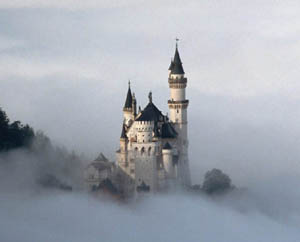
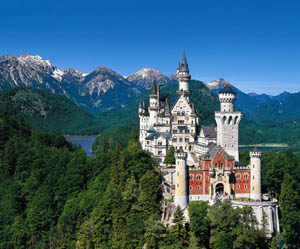
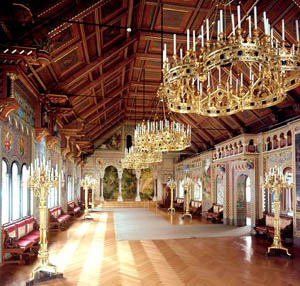
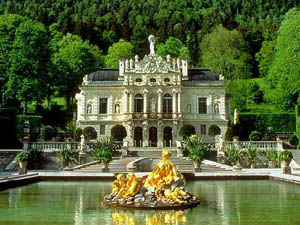

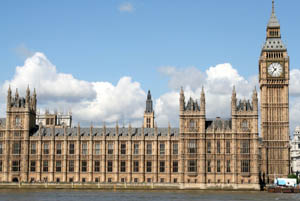

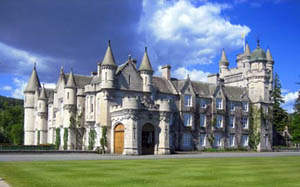


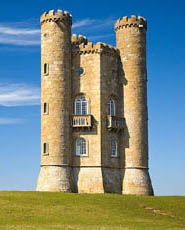
 The
concept of the folly is ambiguous, but they generally have the following
properties:
The
concept of the folly is ambiguous, but they generally have the following
properties: 
